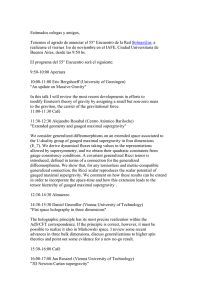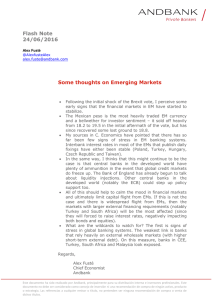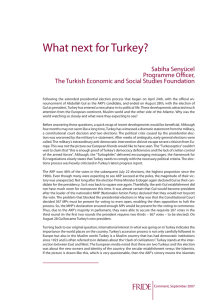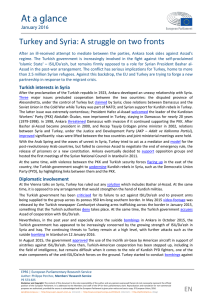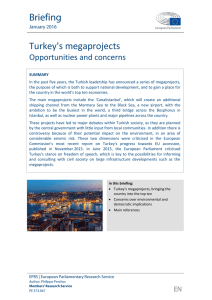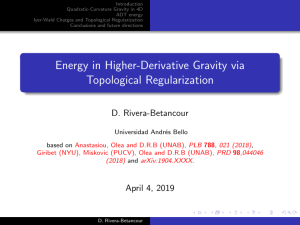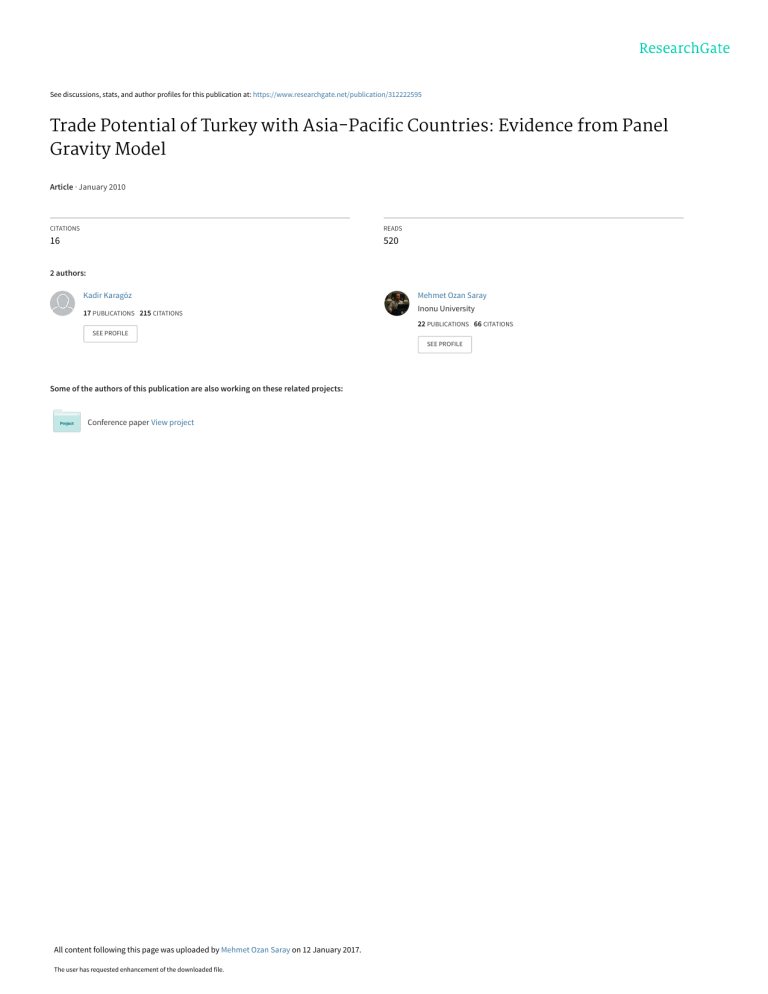
See discussions, stats, and author profiles for this publication at: https://www.researchgate.net/publication/312222595 Trade Potential of Turkey with Asia-Pacific Countries: Evidence from Panel Gravity Model Article · January 2010 CITATIONS READS 16 520 2 authors: Kadir Karagöz 17 PUBLICATIONS 215 CITATIONS Mehmet Ozan Saray Inonu University 22 PUBLICATIONS 66 CITATIONS SEE PROFILE SEE PROFILE Some of the authors of this publication are also working on these related projects: Conference paper View project All content following this page was uploaded by Mehmet Ozan Saray on 12 January 2017. The user has requested enhancement of the downloaded file. International Economic Studies Vol. 36, No. 1 (New Issue), Spring & Summer 2010 pp. 19-26 Received: 1-2-2010 Accepted:20-8-2010 Trade Potential of Turkey with Asia-Pacific Countries: Evidence from Panel Gravity Model Kadir Karagoz* Ph.D. in Economics, Inonu University, FEAS, Malatya, Turkey M. Ozan Saray Inonu University, FEAS, Malatya, Turkey Abstract: As a result of recent developments, global economic centre of gravity has slide to AsiaPacific region. It is predicted that Asia-Pacific countries will take place at the first row in global trade and nearly a half of the total trade will intensify in this region at the year 2030. On the other hand, the region covers countries from different levels of development. These features of the region promise umpteen trade opportunities for countries from other parts of world. Particularly after import-substitution policies were abandoned in favor of trade integration measures since 1980s the share of foreign trade in GDP raised. Recent years have witnessed a more remarkable increase in exports. In this regard, the government started to execute the “Strategy for Developing Commercial and Economic Relations with Asia-Pacific Countries” in 2005. By this plan it was aimed to raise the market shares of Turkish firms in Asia-Pacific countries, to enhance the potential of Turkish defense industry, and to attract more investments from region’s countries which have rich capital accumulation. Thus, the issue of trade potential of Turkey with Asia-Pacific countries gains importance. In this paper we attempt to estimate trade potential for Turkey using the gravity model approach. To this end we use gravity model to first analyze the effective gravitational factors on trade flows and the coefficients thus obtained are then used to estimate the trade potential for Turkey. The results of the fixed effect model reveal that the trade volume between Turkey and Asia-Pacific countries is positively affected from economic size of the countries, while distance plays negative role on trade. The size of the countries with respect to population seems no meaningful effect. On the other hand, * Correspondent Author, Email: [email protected] 20 International Economic Studies, Vol. 36, No. 1 (New Issue), Spring & Summer 2010 depending on the gravity model, our estimates of Turkey’s trade potential for Asia-Pacific countries reveal that the P. N. Guinea, Peru, Myanmar, Mexico, Laos, Brunei promise potential for expansion of trade. Our estimates indicate that Turkey’s actual trade level with rest of the countries in the sample has exceeded her trade potential. Keywords: Trade Potential, Turkey, Panel Data, Gravity Model. JEL Classification: C32, F15 1. Introduction As a result of recent developments, global economic centre of gravity has slide to AsiaPacific region. At the end of the year 2007 foreign trade volume of the region has exceeded 8 trillion USD and 30% of global trade flows has been made over the countries of region. Except for the trade within EU, five out of top ten members of the world trade league are within this region. It is anticipated that, by 2030, the top two countries in global trade will be from Asia-Pacific, with half of all global trade concentrating on the region. Two of the BRIC (Brazil, Russia, India and China) countries, expected by monitoring institutions to become trade leaders in the near future, are also in this region. Furthermore, six of the Next Eleven (N11: Turkey, Vietnam, Bangladesh, Nigeria, Korea, Mexico, Iran, Indonesia, Egypt, Pakistan and the Philippines), considered to be among other prominent players in global trade, are located in the area. On the other hand, the region also accommodates countries with different degrees of development such as OECD members Australia, New Zealand and Japan; BRIC countries China and India; leading ASEAN countries Malaysia, Indonesia, Thailand and Singapore; as well as Afghanistan, Bangladesh and Mongolia, among the least developed countries in the world. Although this may seem like a disadvantage at first in terms of market access, it is in fact an important advantage. The region in question, where a wide variety of goods are produced with different levels of quality in varying quantities, constitutes a huge market with over 3 billion consumers. Turkey has adopted an export-oriented industrialization strategy in the 1980s. Since that date, the main stimulus behind all governments’ economic policy has been the integration of Turkish economy to world markets and promotion of export. So, Turkish trade integration with the rest of the world has considerably increased during the last three decades. For instance, the sum of exports and imports as a share of GDP moved from 24% in 1980 to 79% in 2005. The European Union (EU) is by far Turkey’s main trading partner, accounting for slightly more than half of its exports and slightly less than half of its imports. This state brings in mind that Turkey may have potential for expansion of trade for the rest of the world. Taking into account the global economic trends and developments in Turkey’s economy, especially in its foreign trade, and capitalizing on the experiences and results of the ‘Trade Development Strategies’ towards the ‘Neighboring and Surrounding Countries’ in 2000, and ’African Countries’ in 2003, a new trade development strategy towards ‘AsiaPacific Countries’ was initiated by the government in 2005. The Asia-Pacific Countries strategy is based on boosting general trade and economic relations with the region and getting a share of the region’s markets; attracting investment from those countries of the region with considerable capital accumulation; increasing the market share of Turkish construction, consultancy and engineering companies; and utilizing the potential of Turkish defense industry. The main goal of the Asia-Pacific Countries Strategy is to increase Turkey’s export volume to the region from $2 billion in 2004 to $8 billion by 2010. In this context, the Turkish Confederation of Businessmen and Industrialists (TUSKON), a key player in the effective employment of economic diplomacy among the industry’s leading establishments and a driving force of real economy through the SMEs under its roof, launched a foreign trade bridge program in 2006 and executed a trade summit in 2008 summer, which aimed to bring together the Asian and Turkish businessmen. Thus, the issue of determining the trade potential of Turkey with Asia-Pacific countries gains importance. In this paper we attempt to estimate trade potential for Turkey using the gravity model approach. To this end we use gravity model to first analyze the effective gravitational factors on trade flows and the Trade Potential of Turkey with Asia-Pacific Countries: Evidence from Panel Gravity Model coefficients thus obtained are then used to estimate the trade potential for Turkey. 2. Review of Literature Among the many studies using the gravity framework, a high percentage shares the research task of predicting trade potentials. On the other hand, several studies have analyzed the trade enhancing impact of preferential trading agreements. These studies predict the additional bilateral trade that would be a consequence of the economic integration of set of economies. Both the cross section and panel data approach has been used by these studies. The cross-section as also the panel data approach is mainly static and refers to a long run relationship. Hellvin and Nilsson (2000) have examined to what extent there may be a bias in the trade flows between the major trading blocs: the EU, the NAFTA countries, and ASEM members. They compared actual trade between the blocs with projected trade based on the gravity model estimation. The results they obtained suggest that both the EU’s and NAFTA’s level of trade integration with Asia above the average level of trade integration among the OECD countries, which make out their point of reference. However, the opposite holds for the level of trade integration between the EU and NAFTA. On the other side, trade between NAFTA and Asia are more integrated compared to the EU’s trade with Asia, thereby supporting one of the reasons for the creation of the ASEM. This implies that the EU has lagged behind North America on the Asian market. Hellvin and Nilsson (2000) conclude that the weak link in trade bloc triangle therefore seems to be between the EU and NAFTA rather than between the EU and Asia. Martinez-Zarzoso (2003) has evaluated the determinants of bilateral trade flows among 47 countries and particularly, the effects of preferential agreements between several economic blocs and areas. To this end she has estimated a gravity model that allows the comparison of the weight of the influence of preferential agreements and also, infers the relevance of the other determinants of bilateral trade flows such as geographic proximity, income levels, population and cultural similarities. Impacts of different variables on trade considered. Using the estimation results as a base, trade potentials resulting from new free trade agreements are calculated. The results indicate that the traditional gravity model variables present the expected signs and highlight the role played by intra-bloc effects. 21 Jayasinghe and Sarker (2004) have used an extended gravity model to investigate the trade creation and diversion effect of the North American Free Trade Area (NAFTA) on trade of six selected agricultural -food products from 1985 to 2000. The result shows that the share of intraregional trade is growing within NAFTA and that NAFTA has served to boost trade significantly among its members rather than with the rest of the world. Baier and Bergstrand (2005) have investigated the average treatment effect of free trade agreements (FTAs) on trade, and they found convincing empirical evidence using panel data gravity model. They estimated that an FTA will on average increase two member countries’ trade about 86 percent after 15 years. In his paper, Rojid (2006) has aimed to find out whether COMESA is a building or stumbling block, and to estimate trade potentials, if any, within COMESA region for COMESA members. An extended gravity model was used in the analysis. The results show that COMESA has certainly created more trade within the region than it has diverted for the rest of the world. However, more importantly, it was found that COMESA members are over-trading within the bloc and as such, potentials for more trade exist only for Angola and Uganda. Widgren (2006) has analyzed trade potential, intra-industry trade and comparative advantage in the Baltic Sea Region (BSR). The analysis is carried out at HS 4-digit level. Trade potential is assessed using the gravity model of international trade. Trade flows analysis suggests that the BSR has reached its potential importance in intra-EU25+ (EU25 plus Norway and Russia) trade. The overall conclusion in trade potential analysis is that the centre of gravity within BSR is likely to move gradually to the east. It is also demonstrated in the paper there are big changes in some BSR’s countries specialization patterns. Martinez-Zarzosso and Nowak-Lehmann (2006) had explored the determinants of bilateral trade flows between EU and MERCOSUR countries. To the end of to investigate the relationship between the volume and direction of international trade and the formation of regional trade blocs where members are in different stages of development. The standard gravity model had been augmented with a number of variables, namely infrastructures endowments, squared differences in per capita incomes and real exchange rates, to test whether they are relevant in explaining trade flows. Finally, they have analyzed to what 22 International Economic Studies, Vol. 36, No. 1 (New Issue), Spring & Summer 2010 extent potentials for trade between these two economic areas are important. Estimation results have shown that exporter and importer incomes have a positive influence on bilateral trade. Exporter population has a large and negative effect in exports, whereas importer population has a large and positive effect on exports, indicating that bigger countries import more than small countries. The roles of augmentative variables are also investigated. The results reveal that income differences and exchange rates play as explaining bilateral trade flows in a panel data framework, while infrastructure variable is not statistically significant. 3. The Model: An Application of the Gravity Trade Theory The gravity model belongs to the class of empirical models concerned with the determinants of interactions. In its most general formulation, it explains a flow (of goods, capitals, peoples etc.) from an area to another area as a function of characteristics of the origin, characteristics of the destination and some separation measurement. Customarily the model is estimated in log-linear form (Porojan, 2000). The gravity model has its origin in Newton’s law of gravitation in seventeenth century. Newton’s law of gravity in mechanics states that two bodies are subjected to a force of attraction force that depends positively on the product of their masses and negatively on their distance. Social scholars, in nineteenth century, applied this law to social phenomena of quite different nature the common character of which was transfers or flows between two or more entities or sources. Thus migration or traffic laws (vehicles, information etc.) were examined using this “law” (Simwaka, 2006). Following a specification reminiscent of Newton’s gravitation theory, gravity models relate bilateral trade to the mass of these two countries (commonly measured as the size of the countries involved) and the distance that separates them. This standard formulation of the model, which is consistent with standard models of international trade, is commonly extended to include other factors generally perceived to affect bilateral trade relationships. Indeed, the notion of distance does not only relate to the geographical distance (i.e. transportation costs), but also to other factors affecting transaction costs. Besides or instead of distance variable some other variables also can be used, such as a dummy variable for each of the variables of having common language, common border, being in same territory and same free trade arrangement (Bussiére and Schnatz, 2006). There are several reasons, though, for the inclusion of distance as an explanatory variable. Batra (2004) counts some of these reasons as follows: - Distance is a proxy for costs - Distance is an indicator of the time elapsed during shipment. For perishable goods the probability of surviving intact is a decreasing function of time in transit. - Synchronization costs: when factories combine multiple inputs, the timing of these needs to be synchronised so as to prevent emergence of bottlenecks. Synchronization costs increase with distance. - Transaction costs: distance may be correlated with the costs of searching for trading opportunities and the establishment of trust between potential trading partners. - Cultural distance: it is possible that greater geographical distance is correlated with larger cultural differences. Cultural differences can impede trade in many ways such as inhibiting communication, clashes in negotiating styles etc. In international trade, the gravity model was first introduced by Tinbergen (1962) and Pöyhönen (1963) mainly to account for the patterns of bilateral trade flows among the European countries. Since then, the gravity model has been used and increasingly improved in empirical studies of international trade flows. Linneman (1966) extended the model of Tinbergen to include other trade explanatory variables such as population, and more importantly, complimentarity (Kien and Hashimoto, 2005 and Armstrong, 2007). Most familiar uses of the model relate to: the examination of bilateral trade patterns in search of evidence on natural (non-institutional) regional trading blocs; the estimation of trade creation and trade diversion effects from regional integration, and the estimation of trade potential (Porojan, 2000). Although, the empirical results obtained with the model have always been judged as very good, yet there are a few objections to the model. One is the absence of a cogent derivation of the model, based on economic theory. Several authors have tried to provide the model with such a theoretical basis, notably Anderson (1979), Bergstrand (1985) and more recently Deardorff (1995). However, none of these derivations generates the gravity model as its most general form. It could only be Trade Potential of Turkey with Asia-Pacific Countries: Evidence from Panel Gravity Model approximated under a number of restrictive and unrealistic assumptions. Another imperfection of the gravity model is the absence of substitution between flows and ignoring the third country’s effect on the bilateral trade. In the analysis of international trade, for which purpose the gravity model is frequently used, trade creation and trade diversion are important phenomena (Bikker, 1987). However, there is a huge number of empirical applications in the literature on international trade which have contributed to the improvement of the performance of the gravity equation. Matyas (1997), Breuss and Egger (1999), and Egger (2000) improved the econometric specification of the gravity equation. Basically, the simplest form of the gravity model can be stated as below, T ij A (Y i Y j ) D ij (1) where, Tij is the trade volume between country i and j; A is proportionality constant; Yi and Yj are economic sizes of country i and j (with respect to GDP, GNP or per capita GDP); Dij is the distance between countries. Equation (1) is the core gravity model equation where bilateral trade is predicted to be a positive function of income and negative function of distance. When applied to predict trade flows, population size of both exporter and importer country are often included as variables in the equation, assuming larger populations support and promote larger trade volumes: T ij A ( Y i Y j ) ( Pi P j ) D ij (2) After a simple arrangement, Equation 2 can be written as follow: T ij A ( Pi Y i ) ( P j Y j ) D ij (3) If for the both side logarithms are took, the equation becomes linear: log Tij = A* + log (Pi Yi) + log(Pj Yj) (4) + γ log Dij + εij where, A* is log A, and , , and γ are parameters to be estimated. eij is a white noise error term with constant variance and zero mean, and stands for to represent the random factors those effect bilateral trade. 23 Now trade flows are defined as a function of per capita GDP in two countries and the distance between these countries. Since there is no deviation in (Pi Yi) with respect to the various importer countries, thus it cannot be a source of explanation for trade deviations to those importer countries, and hence can be dropped from the equation (Bos and van de Laar, 2004). The estimable model can be written as: log Tij = A* + log Pj + log Yj + γ log Dij + εij (5) Trade theories based upon imperfect competition and the Hecksher-Ohlin model justify the inclusion of the core variables – income and distance. Most studies have however, included additional dummy variables to control for differences in geographic factors, historical ties and at times economic factors like the overall trade policy and exchange rate risk (Batra, 2004). 3. Data, Definition of the Variables and Estimation of the Model The sample we used covers 23 countries which are members of APEC, except Laos, Cambodia and Myanmar. Economic size (GDP), population (POP) and geographical distance (WDIST) are the explanatory variables of the model, where dependent variable is total foreign trade (i.e. exports plus imports, FT) volume of Turkey with those countries. Since Turkey has no historical, racial and cultural ties with these countries, and did not participated in any common economic organization, we have not included any dummy variables to represent the effects of these factors. So, the model to be estimated includes only the core variables of gravity model, namely the sizes of the countries and the distances from Turkey. The data set contains 5 observations per country per year over 2001-2005, inclusively. Our data set is balanced and includes 460 total observations. It should be said something about the distance variable. The most controversial part of gravity model is, probably, the determination of distance. Some claim that this distance would preferably be the one between commercially important cities of the countries or the distance between capital cities. But, at global scale this choice does not make so much difference. Definition of the distance is also problematic, due to its time invariant nature. Although it is not a problem in cross sectional analysis, when 24 International Economic Studies, Vol. 36, No. 1 (New Issue), Spring & Summer 2010 time dimension entered in the analysis (i.e. panel-data) the variable causes to trouble. In order to overcome this difficulty and to make the distance a varying variable over time, various approaches have been suggested in the literature. These approaches suggest weighted definitions of distance. The distance we adopt in this paper is defined as; WDIST ij ( DISTANCE ij GDP it ) GDP (6) it where, wdistij is the weighted distance between the countries i and j; distij is the geographical distance between the countries i and j; GDPit is GDP of the country i at year t; and ∑GDPi is overall sum of the GDPs of the countries for the years 2001 up to 2005. Standard gravity models generally use cross-section data to estimate trade effects for a particular time period, such as one year, or over averaged data. However, panel data models might provide additional insights, capturing the relevant relationships over time and avoiding the risk of choosing an unrepresentative year. Moreover, panels allow monitoring unobservable individual effects between trading partners. Therefore, in order to investigate the impact of gravitational factors on the trade between Turkey and Asia-Pacific countries, we used panel gravity model framework. Panel data models have three basic approaches: They are pooled and estimated by OLS, or they are assumed to be motivated by fixed effects model (FEM). The third approach is the random effects model (REM). Each approach has its own advantages and disadvantages. As Antonucci and Manzocchi (2005) pointed out REM would be more appropriate when estimating trade flows between a randomly drawn sample of trading partners from larger population. On the other hand, FEM would be a better choice than the REM when one is interested in estimating trade flows between a predetermined selection of countries (Egger, 2000, 2005). Since our sample only contains trade exchanges between Turkey and her main trading partners in the Asia-Pacific region, the FEM might be most appropriate specification. However, the result of Hausman specification test supports our choice. The model to be estimated is below: ln FTit = β0 + β1 ln GDPit + β2 ln POPit (7) + β3 ln WDISTit + εt β1 > 0 β2 > 0 β3 < 0 The random effect regression results are reported in Table 2 below. As it was seen, the trade volume of Turkey with Asia-Pacific countries is significantly affected by the economic size of the partner countries and the distance. The directions of the effects are as in line with the expectations, that is economic size of the countries has a positive effect, whereas distance has negative impact on trade. It seems that the population of the countries has statistically no meaningful effect on trade relations. Table 2: Results of the random effects panel gravity model estimations Std. Error tStatistic Probability -18.0511 * 6.8112 -2.6502 0.010 lnGDP 3.0327 * 0.6589 4.6024 0.000 lnPOP 3.0610 3.0381 1.008 0.316 -2.4231 * 0.8950 -2.7074 0.008 Variable Coefficient Constant lnWDIST R2= 0.992, F-value = 439.544 [Pr = 0.000], D-W = 1.344, Hausman = 3.738 [Pr = 0.291] Note: * denotes the significance at 1% level. Source: Authors 4. Turkey’s Trade Potential Once are estimated the coefficients of the gravity model, we can estimate the trade potential for Turkey. To this end the model estimates from the previous section are used to predict Turkey’s foreign trade (FT) with all the countries in the sample. There are two ways to evaluate trade potential. In the first approach, the ratio of trade potential (FTP) as predicted by the model and actual trade (FTA) i.e. (FTP / FTA) is then used to analyze the future direction of trade for Turkey. If the value of (FTP / FTA) exceeds one, this implicates that there is a potential expansion of trade with the respective country. Depending on the value of (FTP / FTA), Turkey’s trading partners have been divided Trade Potential of Turkey with Asia-Pacific Countries: Evidence from Panel Gravity Model into two categories-those with which potential for expansion of trade is foreseen and countries with which Turkey has already exceeded her trade potential. In second approach, the difference between the potential and actual level of trade i.e. the value of (FTP – FTA) is used to determine the countries with potential for expansion of trade with Turkey. A positive value indicates future possibilities of trade expansion while a negative value shows Turkey 25 has exceeded her trade potential with the particular partner country (Batra, 2004). According to estimated gravity model, the value of (FTP – FTA) is turned out as negative for 16 Asia-Pacific countries, those all developed countries of the region are among them. The value of (FTP – FTA) is positive for only 6 countries, those developing and small countries by a majority. List of the countries for both classes is given below in Table 2. Table 2: List of the countries for both classes of Turkey’s trade Potential (FTP – FTA) < 0 (FTP – FTA) > 0 Papua New Guinea, Peru, Myanmar, Mexico, Laos, U.S.A., Thailand, Taiwan, S. Korea, Singapore, Russia, Brunei N. Zealand, Malaysia, Japan, Indonesia, Hong-Kong, China, Canada, Cambodia, Australia Source: Authors 5. Conclusion In last two decades it seems that the global economic centre of gravity has slide to AsiaPacific region. It is predicted that Asia-Pacific countries will take place at the first row in global trade and nearly a half of the total trade will intensify in this region at the year 2030. On the other hand, the region covers countries from different levels of development. These features of the region promise umpteen trade opportunities for countries from other parts of world. Turkey has adopted an export-oriented industrialization strategy in the 1980s. Since that date, the main stimulus behind all governments’ economic policy has been the integration of Turkish economy to world markets and promotion of export. After 80s Turkey’s export increased substantially. Especially in recent years government has born important initiatives. In this regard, the government started to execute the “Strategy for Developing Commercial and Economic Relations with Asia-Pacific Countries” in 2005. By this plan it was aimed to raise the market shares of Turkish firms in Asia-Pacific countries, to enhance the potential of Turkish defense industry, and to attract more investments from region’s countries which have rich capital accumulation. Thus, the issue of trade potential of Turkey with Asia-Pacific countries gains importance. In this paper we attempt to estimate trade potential for Turkey using the gravity model approach. To this end we use panel gravity model to first analyze the effective gravitational factors on trade flows and the coefficients thus obtained are then used to predict trade potential for Turkey with respect to countries in sample. The results of the fixed effect model reveal that the trade volume between Turkey and AsiaPacific countries is positively affected from economic size of the countries, while distance plays negative role on trade. The size of the countries with respect to population seems no meaningful effect. On the other hand, depending on the gravity model, our estimates of Turkey’s trade potential for Asia-Pacific countries reveal that the P. N. Guinea, Peru, Myanmar, Mexico, Laos, Brunei promise potential for expansion of trade. Our estimates indicate that Turkey’s actual trade level with rest of the countries in the sample has exceeded her trade potential. However, this does not mean that Turkey cannot deepen the trade relations with countries those exceeded her potential. Changing preferences and comparative advantages may cause to increase in trade volume with a particular country. References 1. 2. 3. 4. 5. Anderson, J.E. (1979), “A Theoretical Foundation for the Gravity Equation,” American Economic Review, 93 (1), 170-192 Antonucci, D. and S. Manzocchi (2005), “Does Turkey have a Special Trade Relation with the EU? A Gravity Model Approach,” http://papers.ssrn.com/sol3/ papers.cfm? abstract_id=609881 Armstrong, S. (2007), Measuring Trade and Trade Potential: A Survey, Asia Pacific Economic Papers, 368, Australia-Japan Research Centre. Baier, S.L. and J.H. Bergstrand (2005), Do Free Trade Agreements Actually Increase Members’ International Trade? Working Paper No. 2005-3, Federal Reserve Bank of Atlanta. Batra, A. (2004), India’s Trade Potential: The Gravity Model Approach, Working Paper No. 26 6. 7. 8. 9. 10. 11. 12. 13. 14. 15. 16. 17. 18. View publication stats International Economic Studies, Vol. 36, No. 1 (New Issue), Spring & Summer 2010 151, Indian Council for Research on International Economic Relations. Bergstrand, J. H. (1985), “The Gravity Equation in International Trade: Some Microeconomic Foundations and Empirical Evidence,” Review of Economics and Statistics, 67 (3), 474-481. Bikker, J. A. (1987), “An International Trade Flow Model with Substitution: An Extension of Gravity Model,” Kyklos, 40, 315-337 Bos, J.W.B. and M. van de Laar, (2004), “Explaining Foreign Direct Investment in Central and Eastern Europe: An Extended Gravity Approach,” DNB Working Papers, 008, Netherlands Central Bank. Breuss, F. and P. Egger (1999), “How Reliable are Estimations of East-West Trade Potentials Based on Cross-section Gravity Analyses?” Empirica, 26 (2), 81-95 Bussiére, M. and B. Schnatz (2006), Evaluating China’s Integration in World Trade with a Gravity Model Based Benchmark, W. Paper No. 693, European Central Bank. Deardorff, A. V. (1995), Determinants of Bilateral Trade: Does Gravity Work in a Neoclassic World?, NBER Working Paper No. 5377, p.28 Dikkaya, M. and M. Orhan (2003), “Economies of the Black Sea Economic Cooperation (BSEC) Countries and their Bilateral Trade,” Journal of Economic and Social Research, 6 (2), 63-86. Egger, P. (2000), “A Note on the Proper Econometric Specification of the Gravity Equation,” Economics Letters, 66, 25-31. Egger, P. (2005), “Alternative Techniques for Estimation of Cross-Section Gravity Models,” Review of International Economics, 13 (5), 881891. Hellvin, L. and L. Nilsson (2000), Trade Flows Between Trading Blocs: The Case of the EU’s Trade with Asia and NAFTA, Swedish Network for European Studies in Economics and Business, Discussion Paper, http://www.snee.org/filer/papers/36.pdf Jayasinghe, S. and R. Sarker (2004), “Effects of Regional Trade Agreements on Trade in Agrifood Products: Evidence from Gravity Modeling Using Disaggregated Data,” Working Paper No. 374, Center for Agricultural and Rural Development, Iowa State University. Kien, N.T. and Y. Hashimoto (2005), Economic Analysis of ASEAN Free Trade Area By Country Panel Data, Discussion Paper No. 0512, Osaka School of International Public Policy, Osaka University, Osaka, Japan. Martinez-Zarzoso, I. (2003), “Gravity Model: An Application to Trade between Regional 19. 20. 21. 22. 23. 24. 25. 26. 27. 28. Blocs,” Atlantic Economic Journal, 31 (2), 174187. Martinez-Zarzoso, I. and F. Nowak-Lahmann (2003), “Augmented Gravity Model: An Empirical Application to Mercosur-European Union Trade Flows,” Journal of Applied Economics, 4 (2), 291-316. Matyas, L. (1997), “Proper Econometric Specification of the Gravity Model,” The World Economy, 20 (3), 363-368. Porojan, A. (2000), Trade Flows and Spatial Effects: The Gravity Model Revisited, University of Derby. Pöyhönen, P. (1963), “A Tentative Model for the Volume of Trade Between Countries,” Weltwirtschaftliches Archiv, 90, 23-40 Rojid, S. (2006), “COMESA Trade Potential: A Gravity Approach,” Applied Economics Letters, 13, 947-951. Sayan, S. (1998), Could Regional Economic Cooperation Generate Trade Creation and Trade Diversion Effects without Altering Trade Policies of Members? Preliminary Results from a Gravity Application to BSEC, Discussion Paper No. 98-10, Bilkent University. Simwaka, K. (2006), “Dynamics of Malawi’s Trade Flows: A Gravity Model Approach,” MPRA Paper No. 1122. Tinbergen, J. (1962), an Analysis of World Trade Flows, J. Tinbergen (ed.): in Shaping the World Economy, New York: The Twentieth Century Fund. UNCTAD, Handbook of Statistics, (Online), www.unctad.org Windgren, M. (2006), Trade Potential, Intraindustry Trade and Factor Content of Revealed Comparative Advantage in the Baltic Sea Region, Discussion Papers No. 1034, The Research Institute of the Finnish Economy, Helsinki.
